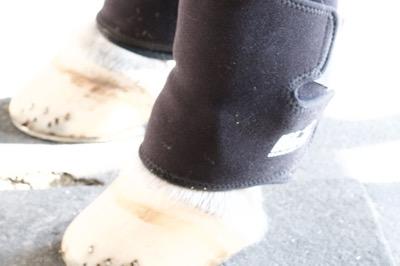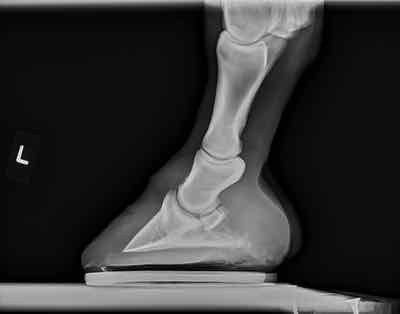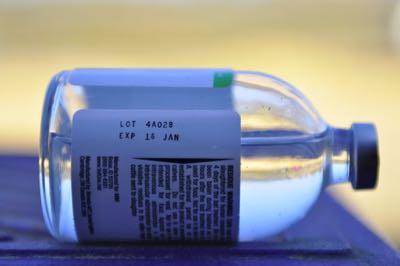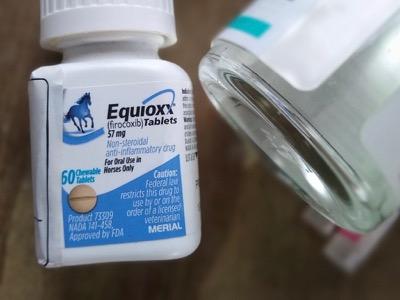What is Ringbone in Horses?
While we all adore our horses for being overachievers in some aspects, it’s not great when they overachieve in bone growth and end up with ringbone. The extra bone growth created may lead to pain, lameness, and interference with tendons and ligaments in the area. Ringbone in horses is a complicated condition with many treatment options.
Table of Contents

What is Equine Ringbone?
- Think of ringbone as extra bone growth around an area, as if the bone has jumped out of its original shape to spread.
- Ringbone happens when your horse’s body creates more bone than it needs. Typically, there is an injury or swelling around the pastern, where the extra bone growth usually occurs.
- Ringbone can happen in the joint, called articular ringbone, or on the side of the pastern bone. The extra calcification and bony proliferations can have zero consequences or be quite dangerous and debilitating.
Where Ringbone Affects Horses
- Ringbone typically occurs around the pastern and fetlock areas. It’s a form of osteoarthritis, a chronic condition in which the articular cartilage breaks down, causing problems with joint mobility. This degenerative joint disease puts additional stress on your horse’s physical and mental well-being.
Equine anatomy refresher
The bones
- The last bone in the horse’s lower limbs is the P3, also called the coffin bone or distal phalanx. Just above that sit the P2, also known as the short pastern bone, and P1, also referred to as the long pastern bone.
- In between the P3 and P2 is the navicular bone, seated at the back of the hoof.
The joints
- Above all of the P’s is the fetlock joint.
- The P3 coffin bone sits inside the hoof. Where the P3 and P2 meet is the coffin joint.
- Where the P2 and P1 meet is the pastern joint, which is also called the proximal interphalangeal joint.

The Types of Ringbone
High ringbone
- Ringbone is a type of arthritis that commonly affects the pastern joint, known as high ringbone. This joint has tons of movement and, therefore, can be painful and problematic if extra bone growth occurs. This is the most common type of ringbone, and the arthritic pain can create long-term lameness.
Low ringbone
- If ringbone interferes with the coffin joint, it’s called low ringbone. This happens just inside the hoof. There’s less movement here than in the pastern joint, but this joint holds your horse’s weight. This situation is also quite painful, as the associated swelling and inflammation have nowhere to go – the hoof capsule contains it all. The coffin joint is prone to degeneration in the face of damage.

The bottom bone here (the P3 Coffin bone) can be seen. This horse’s ringbone was high, affecting the P2 and P1.
Articular ringbone
- If the bony growth occurs on the joint surface, it’s called articular ringbone. This type is more painful and likely to cause severe lameness.
- When the outer layer of bone, the periosteum, is pulled and torn by the soft tissues around a joint, bony growth happens on the joint surfaces.
- Bulky horses with short patterns that tend to weigh more often develop articular ringbone. Their job doesn’t need to be speed-related for this to happen.
Non-articular ringbone
- When the bone grows outside the joint and into surrounding tissues, it’s called non-articular or periarticular ringbone. It’s usually related to high ringbone cases, and lamenesses are not as severe.
Ringbone Causes – Swelling, Osteoarthritis, Infection, Injury
- Horses, like humans, will try to heal themselves and prevent further damage to their bodies. If a horse’s joint starts to experience stress, the surrounding soft tissues also get involved. The tendons and ligaments become inflamed, which can quickly spiral out of control.
- If there’s too much tension in an area, your horse’s body says, “Do something – make it stable again!” Sometimes, stability happens by laying down more BONE. Then, the bone gets in the way of movement.
- It’s a cyclical process – more damage, more bone, more damage, more bone.
Icing a horse’s legs after work can help!

So much ice. So much goodness.
Risk Factors for Ringbone in Horses
- As with all things horses, there’s a lot of genetics, conformation, and a horse’s job that come into play. The development of ringbone doesn’t have a single exact cause.
- The shape of your horse’s legs and hoof plays a significant role here. Poor conformation, with upright pasterns and horses that are toed in, is likely to develop ringbone with degenerative changes.
- Horses subjected to a lot of concussion, like the jumpers, polo ponies, and even some horses in the western disciplines like reining, are more likely to develop ringbone. All of these horse jobs have one thing in common – repetitive stress. It’s wear and tear.
- Footing matters, too. Repeated work on hard ground, especially with young horses, can lead to ringbone. Older horses can also develop ringbone after a lifetime of wear and tear on the limb joints.
- A sudden injury in the pastern region is also a predisposing factor for ringbone. A damaged joint can trigger inflammation that escalates into excessive bone growth.
- Overweight horses are more likely to develop metabolic disorders, like PPID and EMS, and therefore increase laminitis risk. Added weight also strains muscles, joints, tendons, ligaments, and hooves.
Read more about overweight horses here.
Signs of Ringbone
- You may have seen photos of horses with ringbone. You can see the damage and the extra bone that changes the shape of the pastern area. By the time this happens, significant damage and considerable pain will have occurred.
- Like all things horse, signs of ringbone are subtle. It might start with a lameness or a different way of going, which should always be checked out. Early intervention is key. Even mild or moderate lameness may be linked to ringbone.
- You may also notice that your horse’s pastern area is swollen or warm. Or your horse is flinching when you inspect the coronary bands.
- You or your vet may be able to feel changes during palpation of the pastern. Abnormal bone development in that area is a source of pain that can be palpated and sometimes visualized.
- Under saddle, you may find your horse’s gait choppy, different, or tight. A horse in pain often loses forwardness and may become unwilling to turn or jump.
- The signs of ringbone are subtle, so keep a close eye on the situation and notice any trends over time.
- The early stages of ringbone can be vague and resemble many other conditions, so it’s vital to involve your vet early on.

Your vet will need X-rays for a diagnosis.
How a Veterinarian Makes a Diagnosis
- A lameness exam is the first step in uncovering the cause of severe lameness or chronic lameness, which is subtle and mysterious. Any acute trauma to the area from an accident also warrants a thorough exam.
- A lameness evaluation usually begins with flexion tests. Your vet will flex and hold a joint and then watch as they trot away.
- To help pinpoint specific areas and joints, your vet may perform nerve blocks. Starting low in the leg, the area is numbed, and the flexions are repeated. That area is likely involved if the numbing changes how your horse responds to the flexion test.
- The diagnosis of ringbone typically involves X-rays and, in some cases, ultrasound. Several imaging techniques can help your vet narrow down causes and a treatment plan when evaluating joint health.
- You can physically see the bony changes that ringbone can create. Ringbone is a degeneration of the area and does not have a cure.
What’s the Prognosis?
- While there is no cure for ringbone, many horses find comfort depending on the severity of the condition.
- Try different therapies, like shockwave therapy, to find the best fit for your horse.
- Because this is a degenerative condition, the stiffness, mobility, and pain will change over time. The progression of the disease is not kind to some horses.

Corrective shoeing can be helpful.
Shoeing and Hoof Care with Your Vet and Farrier
- One place to begin helping your horse is by adjusting trimming and shoeing. If there are recent radiographs, these can help your farrier and vet come up with a hoof care treatment plan that mirrors their exact anatomy.
- Your farrier can adjust the breakover point so that the hoof lifts off the ground more quickly than usual.
- For the heels, supportive shoeing can help reduce pain. Pads, pour-ins, bar shoes, and other horseshoe variations support the heel better than plain shoes or barefoot trimming.

Ringbone can happen in any leg.
Nutraceuticals, Supplements, and Medications for Inflammation
- There are plenty of joint supplements available to support joint and bone health.
Hyaluronic acid
- Hyaluronic acid (HA) is a natural substance that works to grease and cushion joints. There are oral forms and injectables, which directly target the specific joint.
- It’s found in the synovial fluid surrounding joints and helps reduce inflammation. When injected, it also prompts the joint cartilage to make more HA.
Methylsulfonylmethane (MSM)
-
- This inexpensive supplement has many functions. First, it may help alleviate joint swelling, especially when associated with arthritis rather than an injury.
-
- Range of motion and recovery after exercise may also improve.
-
- MSM may also stimulate the production of cartilage cells, act as an antioxidant, and support a healthy immune system.

Stabilized or cold-milled flax is delicious and so easy to feed.
Omega-3 fatty acids
- Omega-3 fatty acids help your horse make prostaglandins, which are anti-inflammatory compounds. These acids also help support cartilage and other soft tissues, such as tendons and ligaments.
- The horse’s body needs Omega-3s and Omega-6s, but a healthy ratio is generally at least 4:1. A horse’s diet often lacks enough 3s to make this happen. Look for flax, chia, and fish oils to supply Omega-3s. Like MSM, it’s affordable and plentiful.
Snake oil or valuable supplement?
- The nutraceutical industry is not regulated in the same way as the pharmaceutical industry. The FDA regulates companies, and supplements are treated as a subset of food, not medicine.
- Supplements only have to be safe to consume, nothing else.
- For horse owners, we need to differentiate between testimonials and science and ignore fancy marketing.
- Many nutraceutical companies back their products with objective science, and it’s easy to find on a manufacturer’s website if you are looking for studies. Ideally, you can also find information about a specific product in a scholarly article.
Prescription Medications for Ringbone in Horses
Anti-inflammatory meds
- Bute, Banamine, and firocoxib are the big three pain medications for horses. These work on your horse’s entire body and are generally not intended for long-term use. Each has a different mechanism in the body and may exacerbate ulcers.
Bisphosphonates
- Bisphosphonate drugs interfere with bone remodeling. You may have heard of these to treat navicular diseases. For horses with ringbone, these help relieve pain and strengthen the bones.
Injections
- Aside from intra-articular injections of HA, your vet can use steroids in the joints. Direct injection is a powerful way to deliver more benefit to the exact location. However, not all horses are candidates for steroid injections.
- Joint injections made from your horse’s blood are another option. Cells taken from your horse’s blood are spun down and multiplied before re-injection into an area. Two methods are interleukin-1 receptor antagonist protein (IRAP) and platelet-rich plasma (PRP). A new IRAP/PRP combo product called Pro-Stride may also be an option for your horse.

Many good things come in bottles.
Surgical Options for Ringbone in Horses
Non-surgical joint fusion
- Fusion occurs naturally when the cartilage degenerates and the bone surfaces join together.
- Your vet can inject the joint with medications to hasten this process, which triggers your horse to fuse their joint.
- While this is less expensive than surgery, it’s not as accurate and may be unsuccessful.
Surgical joint fusion
- When it comes to surgical fusion, the procedure is best done in high ringbone situations. A fused coffin joint is best for horses that will be pasture ornaments.
- The surgeon will physically remove the cartilage in the joint. Plates and screws join the bones together. Recovery is a long process, and outcomes are uncertain. For low-impact horse jobs, like light trail riding, return to work is more likely than if a big-time show jumper came back to work.
This older science has some great photos of ringbone surgery.

This horse had surgery to fuse the pastern joint. You can see one of the three screws here, going from P1 into P2.
Ringbone in horses does take time to develop. Working closely with your vet over time is a great place to start. Do try to avoid the denial that something is ever so slightly wrong with your horse and that he will “work out of it” in time. Be the best advocate for your horse and seek veterinary care early. Effective management of ringbone relies on early detection and prompt treatment.

That’s a lot of strain on the legs!
FAQ’s
What are the main causes and risk factors for ringbone in horses?
Ringbone is caused by joint injury, repeated stress, arthritis, or infection, with the risk increased in horses with upright pasterns, a heavy build, hard work on tough footing, or a genetic predisposition. There are various treatment options, including both surgical and non-surgical approaches.
What is false ringbone in horses?
False ringbone, or non-articular ringbone, happens when extra bone growth forms outside the joint. Typically, this causes less severe lameness than extra bone within the joint. Regular X-rays and veterinary care can track the progression of this disease.
How long can horses live with ringbone?
Equines can live a full life with ringbone, although their comfort and performance depend on the severity and management of the condition. Diet, exercise, footing, overall health, and hoof care play essential roles in hoof and bone health.
How Does the Climate or Weather Affect a Horse With Ringbone?
Cold, damp, or hard footing can exacerbate stiffness and discomfort in horses with ringbone, making movement more painful. Warmer months may alleviate some pain, and appropriate exercise can help in all weather. Your veterinarian can help you develop an exercise program and a suitable diet.
How does corrective shoeing help ringbone?
Corrective shoeing reduces stress on affected joints, supports the hoof, improves breakover, and can help relieve pain and inflammation. Your veterinarian and farrier can use X-rays to monitor the bones inside the hoof, identifying the best angles and support options.
Go Shopping

Stock up here for your horse supplies! As an Amazon Associate, I earn from qualifying purchases, but it’s ZERO extra cents to you. As a Walmart Associate, I earn from qualifying purchases as part of their affiliate plan. Thank you for your support! You can also visit my Amazon storefront here: PEG storefront. You can visit my Walmart shop here: Walmart shop. Thank you!
Omega 3's plus gut health support in a delicious cold milled flax formula. It's delicious and it will turn your horse's coat into a mirror.
Take the heat out, reduce inflammation, help prevent long-term damage, and dress your horse in cute colors after a ride.
If hooves are your jam, this book is for you.
Resources
HAAKENSTAD, L. H. (1969). Chronic bone and joint diseases in relation to conformation in the horse. Equine Veterinary Journal, 1(6), 248-260.
Neubauer, H. (1968). Radiographic demonstration of induced periarticular and articular arthritis in the stressed skeletally immature horse (Equus caballus).
Zubrod, C. J., & Schneider, R. K. (2005). Arthrodesis techniques in horses. Veterinary Clinics: Equine Practice, 21(3), 691-711.









